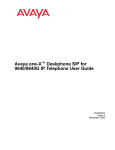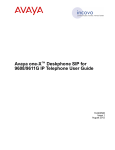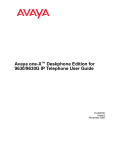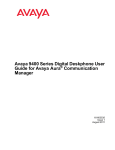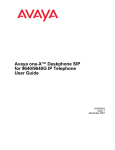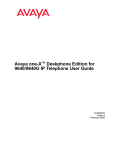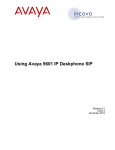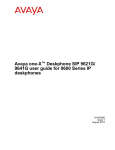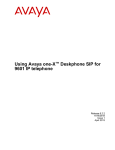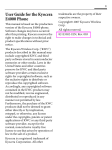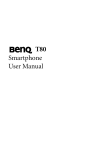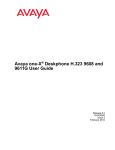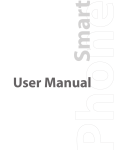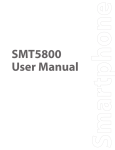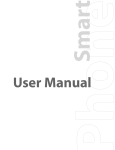Download Avaya one-X™ Deskphone SIP for 9608/9611G IP Telephone User
Transcript
Avaya one-X™ Deskphone SIP for 9608/9611G IP Telephone User Guide 16-603595 Issue 1 September 2010 © 2010 Avaya Inc. All Rights Reserved. Notice While reasonable efforts have been made to ensure that the information in this document is complete and accurate at the time of printing, Avaya assumes no liability for any errors. Avaya reserves the right to make changes and corrections to the information in this document without the obligation to notify any person or organization of such changes. Note Using a cell, mobile, or GSM phone, or a two-way radio in close proximity to an Avaya IP telephone might cause interference. Documentation disclaimer Avaya shall not be responsible for any modifications, additions, or deletions to the original published version of this documentation unless such modifications, additions, or deletions were performed by Avaya. End User agree to indemnify and hold harmless Avaya, Avaya's agents, servants and employees against all claims, lawsuits, demands and judgments arising out of, or in connection with, subsequent modifications, additions or deletions to this documentation, to the extent made by End User. Link disclaimer Avaya is not responsible for the contents or reliability of any linked Web sites referenced within this site or documentation(s) provided by Avaya. Avaya is not responsible for the accuracy of any information, statement or content provided on these sites and does not necessarily endorse the products, services, or information described or offered within them. Avaya does not guarantee that these links will work all the time and has no control over the availability of the linked pages. Warranty Avaya provides a limited warranty on this product. Refer to your sales agreement to establish the terms of the limited warranty. In addition, Avaya’s standard warranty language, as well as information regarding support for this product, while under warranty, is available to Avaya customers and other parties through the Avaya Support Web site: http://www.avaya.com/support. Please note that if you acquired the product from an authorized Avaya reseller outside of the United States and Canada, the warranty is provided to you by said Avaya reseller and not by Avaya. Licenses THE SOFTWARE LICENSE TERMS AVAILABLE ON THE AVAYA WEBSITE, HTTP://SUPPORT.AVAYA.COM/LICENSEINFO/ ARE APPLICABLE TO ANYONE WHO DOWNLOADS, USES AND/OR INSTALLS AVAYA SOFTWARE, PURCHASED FROM AVAYA INC., ANY AVAYA AFFILIATE, OR AN AUTHORIZED AVAYA RESELLER (AS APPLICABLE) UNDER A COMMERCIAL AGREEMENT WITH AVAYA OR AN AUTHORIZED AVAYA RESELLER. UNLESS OTHERWISE AGREED TO BY AVAYA IN WRITING, AVAYA DOES NOT EXTEND THIS LICENSE IF THE SOFTWARE WAS OBTAINED FROM ANYONE OTHER THAN AVAYA, AN AVAYA AFFILIATE OR AN AVAYA AUTHORIZED RESELLER, AND AVAYA RESERVES THE RIGHT TO TAKE LEGAL ACTION AGAINST YOU AND ANYONE ELSE USING OR SELLING THE SOFTWARE WITHOUT A LICENSE. BY INSTALLING, DOWNLOADING OR USING THE SOFTWARE, OR AUTHORIZING OTHERS TO DO SO, YOU, ON BEHALF OF YOURSELF AND THE ENTITY FOR WHOM YOU ARE INSTALLING, DOWNLOADING OR USING THE SOFTWARE (HEREINAFTER REFERRED TO INTERCHANGEABLY AS “YOU” AND “END USER”), AGREE TO THESE TERMS AND CONDITIONS AND CREATE A BINDING CONTRACT BETWEEN YOU AND AVAYA INC. OR THE APPLICABLE AVAYA AFFILIATE (“AVAYA”). capacity for which the license is granted will be one (1), unless a different number of licenses or units of capacity is specified in the Documentation or other materials available to End User. “Designated Processor” means a single stand-alone computing device. “Server” means a Designated Processor that hosts a software application to be accessed by multiple users. “Software” means the computer programs in object code, originally licensed by Avaya and ultimately utilized by End User, whether as stand-alone products or pre-installed on Hardware. “Hardware” means the standard hardware originally sold by Avaya and ultimately utilized by End User. License types Designated System(s) License (DS). End User may install and use each copy of the Software on only one Designated Processor, unless a different number of Designated Processors is indicated in the Documentation or other materials available to End User. Avaya may require the Designated Processor(s) to be identified by type, serial number, feature key, location or other specific designation, or to be provided by End User to Avaya through electronic means established by Avaya specifically for this purpose. Shrinkwrap License (SR). With respect to Software that contains elements provided by third party suppliers, End User may install and use the Software in accordance with the terms and conditions of the applicable license agreements, such as “shrinkwrap” or “clickwrap” license accompanying or applicable to the Software (“Shrinkwrap License”). The text of the Shrinkwrap License will be available from Avaya upon End User’s request (see “Third-party Components” for more information). Copyright Except where expressly stated otherwise, no use should be made of materials on this site, the Documentation(s) and Product(s) provided by Avaya. All content on this site, the documentation(s) and the product(s) provided by Avaya including the selection, arrangement and design of the content is owned either by Avaya or its licensors and is protected by copyright and other intellectual property laws including the sui generis rights relating to the protection of databases. You may not modify, copy, reproduce, republish, upload, post, transmit or distribute in any way any content, in whole or in part, including any code and software. Unauthorized reproduction, transmission, dissemination, storage, and or use without the express written consent of Avaya can be a criminal, as well as a civil, offense under the applicable law. Third-party components Certain software programs or portions thereof included in the Product may contain software distributed under third party agreements (“Third Party Components”), which may contain terms that expand or limit rights to use certain portions of the Product (“Third Party Terms”). Information regarding distributed Linux OS source code (for those Products that have distributed the Linux OS source code), and identifying the copyright holders of the Third Party Components and the Third Party Terms that apply to them is available on the Avaya Support Web site: http://www.avaya.com/support/Copyright/. T9 Text Input and other products are covered by one or more of the following patents: U.S. Pat. Nos. 5,187,480,5,818,437, 5,945,928, 5,953,541, 6,011,554, 6,286,064, 6,307,548, 6,307,549, and 6,636,162,6,646,573, 6,970,599; Australia Pat. Nos. 727539, 746674, 747901; Austria Pat. Nos. AT225534, AT221222; Brazil P.I. No. 9609807-4; Canada Pat. Nos. 1,331,057, 2,227,904,2,278,549, 2,302,595; Japan Pat. Nos. 3532780, 3492981; United Kingdom Pat. No. 2238414B; Hong Kong Standard Pat. No. HK1010924; Republic of Singapore Pat. Nos. 51383, 66959, 71979; European Pat. Nos. 1 010 057 (98903671.0), 1 018 069 (98950708.2); Republic of Korea Pat. Nos. KR201211B1, KR226206B1, 402252; People's Republic of China Pat. No. ZL96196739.0; Mexico Pat. Nos. 208141, 216023, 218409; Russian Federation Pat. Nos. 2206118, 2214620, 2221268; additional patent applications are pending Avaya grants End User a license within the scope of the license types described below. The applicable number of licenses and units of 2 Avaya one-X™ Deskphone SIP for 9608/9611G IP Telephone User Guide September 2010 Preventing toll fraud “Toll fraud” is the unauthorized use of your telecommunications system by an unauthorized party (for example, a person who is not a corporate employee, agent, subcontractor, or is not working on your company's behalf). Be aware that there can be a risk of toll fraud associated with your system and that, if toll fraud occurs, it can result in substantial additional charges for your telecommunications services. Avaya fraud intervention If you suspect that you are being victimized by toll fraud and you need technical assistance or support, call Technical Service Center Toll Fraud Intervention Hotline at +1-800-643-2353 for the United States and Canada. For additional support telephone numbers, see the Avaya Support Web site: http://www.avaya.com/support/. Suspected security vulnerabilities with Avaya products should be reported to Avaya by sending mail to: [email protected]. Trademarks All other trademarks are the property of their respective owners. Downloading documents For the most current versions of documentation, see the Avaya Support Web site: http://www.avaya.com/support Contact Avaya Support Avaya provides a telephone number for you to use to report problems or to ask questions about your product. The support telephone number is 1-800-242-2121 in the United States. For additional support telephone numbers, see the Avaya Web site: http://www.avaya.com/ support Warning The handset receiver contains magnetic devices that can attract small metallic objects. Care should be taken to avoid personal injury. Power over Ethernet (PoE) warning This equipment must be connected to PoE networks without routing to the outside plant. VCCI-Class B statement: This is a Class B product based on the standard of the VCCI Council. If this is used near a radio or television receiver in a domestic environment, it may cause radio interference. Install and use the equipment according to the instruction manual. Avaya one-X™ Deskphone SIP for 9608/9611G IP Telephone User Guide September 2010 3 4 Avaya one-X™ Deskphone SIP for 9608/9611G IP Telephone User Guide September 2010 Contents Chapter 1: Introduction to the 9608/9611G SIP Deskphone..................................................9 Overview...........................................................................................................................................................9 Scrolling and navigation..................................................................................................................................11 About icons.....................................................................................................................................................12 Administrative messages................................................................................................................................13 Telephone stand..............................................................................................................................................13 Viewing Network Information...........................................................................................................................14 Chapter 2: Avaya Menu...........................................................................................................15 Options & Settings..........................................................................................................................................16 Setting the Phone Screen on calling......................................................................................................17 Setting the Phone Screen on ringing......................................................................................................17 Displaying call timers..............................................................................................................................18 Setting redial options..............................................................................................................................18 Configuring visual alerts.........................................................................................................................19 Setting the audio path.............................................................................................................................19 Setting dialing options............................................................................................................................20 Setting up speed dialing.........................................................................................................................20 Setting up favorites.................................................................................................................................21 Personalizing button labels.....................................................................................................................21 Adjusting the brightness or contrast of the display.................................................................................22 Changing the ring pattern.......................................................................................................................23 Setting a call pickup ring tone.................................................................................................................24 Setting call pickup alerting indication......................................................................................................24 Changing the background logo...............................................................................................................25 Turning button click sounds on and off...................................................................................................25 Turning error tones on or off...................................................................................................................25 Setting the Phone screen width..............................................................................................................26 Changing the language..........................................................................................................................26 Setting the time format...........................................................................................................................27 Turning automatic gain control on or off.................................................................................................27 Integrating other applications with your phone.......................................................................................28 Chapter 3: Answering a call...................................................................................................31 Ignoring an incoming call................................................................................................................................31 Putting a call on hold.......................................................................................................................................32 Muting a call....................................................................................................................................................32 Transferring a call............................................................................................................................................32 Chapter 4: Making a call.........................................................................................................35 Making an emergency call..............................................................................................................................35 Redialing a number.........................................................................................................................................36 Speed dialing a person...................................................................................................................................36 Autodialing a pre-assigned number................................................................................................................36 Making a call using edit dialing.......................................................................................................................37 Calling a person from the contacts list............................................................................................................37 Calling a person from call history....................................................................................................................38 Making a call using a “click to dial” link...........................................................................................................38 Avaya one-X™ Deskphone SIP for 9608/9611G IP Telephone User Guide September 2010 5 Chapter 5: Forwarding calls...................................................................................................39 Send All Calls..................................................................................................................................................39 Forwarding calls..............................................................................................................................................39 Turning off call forwarding...............................................................................................................................40 Chapter 6: Conference calls...................................................................................................41 Setting up a conference call............................................................................................................................41 Adding a person on hold to a conference call.................................................................................................41 Putting a conference call on hold....................................................................................................................42 Dropping the last person added to a conference call......................................................................................42 Chapter 7: Bridged call appearances....................................................................................43 Answering a call on a bridged line..................................................................................................................43 Joining a call on a bridged line........................................................................................................................43 Making an outgoing call on a bridged line.......................................................................................................44 Excluding others from bridging onto your call.................................................................................................44 Transferring a bridged call to its own voice mail.............................................................................................44 Chapter 8: Contacts................................................................................................................47 Searching for a contact...................................................................................................................................47 Extended searching........................................................................................................................................48 Viewing a contact's details..............................................................................................................................48 Adding a new contact......................................................................................................................................49 Editing a contact..............................................................................................................................................50 Deleting a contact...........................................................................................................................................50 Chapter 9: Call History............................................................................................................51 Viewing call history..........................................................................................................................................51 Viewing call history details..............................................................................................................................51 Adding an entry from the call history to your contacts list...............................................................................52 Removing an entry from call history................................................................................................................52 Clearing all call history entries........................................................................................................................53 Turning off call history.....................................................................................................................................53 Chapter 10: Getting your messages......................................................................................55 Logging into your voice mail............................................................................................................................55 Chapter 11: About Features....................................................................................................57 Accessing the Features menu.........................................................................................................................57 Feature Table..................................................................................................................................................57 Monitoring other extensions at a glance.........................................................................................................59 Assigning labels to pre-assigned (Autodial) numbers.....................................................................................59 Setting up automatic call back........................................................................................................................60 Making an auto intercom call..........................................................................................................................60 Call Forwarding when your line is busy or if you don't answer........................................................................61 Blocking your extension from displaying during calls......................................................................................61 Displaying your extension on outgoing calls...................................................................................................62 Parking a call...................................................................................................................................................62 Unparking a call..............................................................................................................................................62 Picking up a call to another extension.............................................................................................................63 Picking up a call to another call pickup group.................................................................................................63 Picking up a call from your pickup group........................................................................................................64 6 Avaya one-X™ Deskphone SIP for 9608/9611G IP Telephone User Guide September 2010 Calling someone in your intercom group.........................................................................................................64 Tracing a malicious call...................................................................................................................................64 Recording a call..............................................................................................................................................65 Making a priority call.......................................................................................................................................65 Interrupting a call with a whisper page............................................................................................................66 Configuring simultaneous ringing for multiple telephones (EC500)................................................................66 Extending a call to your cell phone (EC500)..........................................................................................67 Chapter 12: Browser...............................................................................................................69 Navigating Web pages....................................................................................................................................69 About Web browser icons and labels..............................................................................................................70 Chapter 13: Using the Calendar.............................................................................................71 Calendar Appointment Reminders..................................................................................................................71 Reviewing your appointments.........................................................................................................................71 Chapter 14: Limited access during failover..........................................................................73 Chapter 15: About locking and logging in to and out of your telephone...........................75 Logging in to your telephone extension..........................................................................................................75 Locking and unlocking your telephone............................................................................................................76 Logging out of your telephone extension........................................................................................................76 Index.........................................................................................................................................77 Avaya one-X™ Deskphone SIP for 9608/9611G IP Telephone User Guide September 2010 7 8 Avaya one-X™ Deskphone SIP for 9608/9611G IP Telephone User Guide September 2010 Chapter 1: Introduction to the 9608/9611G SIP Deskphone Your deskphone provides many features, including a Phone screen to view and manage your calls, call History, a Contacts list, an integrated WML browser, a menu of options and settings, and access to your voicemail. You can also attach up to three button modules to your telephone, to expand the available number of call appearances and features; multiple button modules must all be the same type and model. The 9611G Deskphone provides this information in color, while the 9608 model provides this information in black and white. The "G" designation in 9611G means this deskphone model has a built-in Gigabit Ethernet adapter which speeds data transmission. The 9608 Deskphone has a smaller display area than the 9611G Deskphone. Unless specifically stated elsewhere in this guide, the two models are essentially the same in terms of features and functionality. Not all functions and features described in this user guide may be available on your deskphone. If you find that a function or feature is not available, please contact your system administrator. Overview Avaya one-X™ Deskphone SIP for 9608/9611G IP Telephone User Guide September 2010 9 Introduction to the 9608/9611G SIP Deskphone The following table provides button/feature descriptions for the 9608/9611G deskphone. Name 10 Description Message Waiting Indicator An illuminated red light in the upper-right corner of your phone indicates you have voicemail messages waiting. If visual alerting is enabled, this light flashes when you receive an incoming call. Missed Call Indicator The icon on the History button is illuminated when you have missed calls. The top line shows the Missed Call icon and the number of calls missed. Prompt Line View the prompt line to see helpful information, such as when you can use the right or left navigation arrows to view alternate screens or menus. Call Appearances The number of lines available to make or receive calls (call appearances) depend on how your system is administered. Press the line button to initiate or answer a call. Lines The line buttons with integrated LEDs show which lines are in use and correspond to the lines on the display. Press the line button to select Avaya one-X™ Deskphone SIP for 9608/9611G IP Telephone User Guide September 2010 Scrolling and navigation Name Description that line. Lines also indicate if a feature or system number (for example, an autodial number) is enabled or disabled in the Feature or System Numbers view. Softkeys Use the softkeys to act on objects displayed on the screen. The softkey labels show you the action that each key produces. Message Press the Message button to connect directly to your voicemail system. Navigation Arrows Use the right and left navigation arrows to navigate between menus or to move the cursor during text input. Use the up and down navigation arrows to move from one line to another. Phone Press Phone to view and manage your calls. Contacts Press Contacts to view the entries in your Contacts list. History Press History to view the history of your outgoing, incoming, and missed calls. Home Press Home to configure options and settings, access the browser, log out, or view network information. Volume Press Volume to adjust the volume of the handset, headset, speaker, and ringer. Headset Press Headset to use the headset if it is connected. Only HIS headset cords are compatible with your phone. Mute Press Mute to mute a call in progress. To take a call off mute, press Mute again. Speaker Press Speaker to use the speakerphone. To take a call off speakerphone, lift the handset. Scrolling and navigation A navigation icon appears in the phone display to indicate that you can scroll to more options or information. Use the right and left navigation arrows to move between the Phone screen and Features list or the Features list and System Numbers list. Go to other screens when the paging icon (left- and right-facing arrows) displays on a line or to move the cursor right or left when entering text. The softkey labels will change according to the options available for the selected line. The OK button is a shortcut for the default action. For example, when you select an entry in your contacts list, pressing the OK button places a call to that person. Avaya one-X™ Deskphone SIP for 9608/9611G IP Telephone User Guide September 2010 11 Introduction to the 9608/9611G SIP Deskphone About icons The icons in the following table indicate the state of a call, navigation choices, or the status of a contact whose presence you are tracking. Icon Description Missed call; a call was not answered or was forwarded to voice mail. Incoming call is alerting. Call is active. Call is on hold. Conference is active. Conference is on hold. Use the Right or Left navigation arrow to see additional pages/screens/options. Scroll left for other options. Scroll right for other options. Scroll up or down when there is more information than can display in the application area. The call in progress is muted. The icon shown applies to the 9608 only. The ringer volume is off due to pressing - on the Volume button until the volume turns off. To reinstate volume, press + on the Volume button. The icon shown applies to the 9611 only. The ringer volume is off due to pressing - on the Volume button until the volume turns off. To reinstate volume, press + on the Volume button. Presence icon signifying this contact is available; the contact whose presence is indicated is registered (logged in) and that phone is in an idle state. Presence icon signifying this contact is currently on his or her phone; Busy indicator. Presence icon indicating this contact is not logged in (unregistered). 12 Avaya one-X™ Deskphone SIP for 9608/9611G IP Telephone User Guide September 2010 Administrative messages Icon Description Presence icon indicating this contact's phone is busy with the Send All Calls feature active. This icon also designates that a feature is not available at this point of a call. Presence icon indicating this contact is away from the telephone. Icon indicating the telephone is not connected to its network and is operating in "failover" mode. Some features may not be available or work correctly. See Limited access during failover on page 73 for information. This contact or feature is designated a "favorite." See Setting up favorites on page 21 for more information. Presence icons appear when you set up the person whose presence you want to track as a contact and enter a handle (a phone number or URI) for that person. Administrative messages Your administrator can send important messages directly to your telephone, for example, notification of an early office closing due to inclement weather or information about an imminent service interruption. These types of messages can take any of the following forms: • a text message streaming across the top display line, accompanied by an audible alert, • an audio message broadcasting through the Speaker (or the headset if that device is active), • an “interrupt” screen notifying you that you are receiving an audio alert, with instructions for canceling the message or resuming your previous activity, such as continuing a call. While receiving an audio message, you can switch between the Speaker, handset, and headset as desired, can terminate the pushed audio content by “going on-hook,” and can adjust the volume, as you normally would during a call. Telephone stand The telephone stand attaches to the phone in one of two ways so that you can place the phone in a relatively flat position or at an angle. If your phone is in the upright position for wall mounting, reverse the tab located below the switchhook in the top ear piece pocket (on the Avaya one-X™ Deskphone SIP for 9608/9611G IP Telephone User Guide September 2010 13 Introduction to the 9608/9611G SIP Deskphone front of the phone). This will keep the handset seated in the correct position. You will need a small screwdriver to lift this tab out. Viewing Network Information Your system administrator may ask you to check certain phone or network settings to investigate problems. Access network information from the Home Screen. Network Information has seven different viewing options: Audio parameters, IP (Internet Protocol) parameters, Quality of Service, Interfaces, 802.1X Parameters, Miscellaneous, and Diagnostics. Your system administrator will instruct you further as to which network information options and settings are needed. 14 Avaya one-X™ Deskphone SIP for 9608/9611G IP Telephone User Guide September 2010 Chapter 2: Avaya Menu You can use the Avaya Menu to adjust and customize options and settings for your telephone, access additional Web-based applications, get information about your phone and network settings, and log out. When you press the Home button, you see one of the following menus, depending on how your administrator has set up your system and on the applications available to you: Note: The menus and sub-menus that appear depend on how your extension was administered. Some options or sub-menus may not be available. Contact your System Administrator if you have any questions. • Options & Settings... • Browser... • Network Information... • About Avaya one-X • Log Out Options & Settings lets you change your call settings, personalize button labels, adjust brightness and contrast, select your ringing pattern, set up favorites, assign speed dial entries, and more. See Options & Settings on page 16 for more information. The Browser menu contains additional web-based applications. (If no web applications are available for your phone, the Browser menu is not shown.) Network Information shows a summary of network-related parameters for your phone and provides diagnostic information. See Viewing Network Information on page 14 for information. If your administrator has set up Web applications, this option appears under the Phone Settings menu instead. About Avaya one-X provides the release number of your telephone software. Log Out lets you sign off the phone, to protect your settings or to allow another user to log in. Avaya one-X™ Deskphone SIP for 9608/9611G IP Telephone User Guide September 2010 15 Avaya Menu Options & Settings The Options & Settings menu contains choices for: • Call Settings... • Assign Speed Dial Entries... • Assign Favorites Entries... • Application Settings... • Screen & Sound Options... • Language and Region... • Advanced Options... Call Settings includes choices for automatically displaying the Phone screen when you get an incoming call or when you place a call, turning call timers on or off, controlling how Redial works, turning Visual Alerting on or off, and more. Assign Speed Dial Entries lets you assign speed dial numbers to up to ten contacts, so you can press a single digit to initiate a call to that person. See Setting up speed dialing on page 20 for more information. Assign Favorites Entries lets you build a list of up to nine favorite contacts or features. See Setting up favorites on page 21 for more information. Application Settings includes choices for personalizing button labels, turning call History on or off and including bridged calls in your call History. Screen & Sound options includes choices for adjusting your phone's brightness and contrast, ring pattern, background logos, and button clicks and tones. Language and Region settings includes choices for setting the display language and the time format. Advanced Options includes choices for integrating other applications like Microsoft® Exchange Server with your phone. You can also set AGC (Automatic Gain Control) for your headset, handset, and/or speaker audio. Network Information has a sub-menu with six different viewing options: Audio parameters, IP (Internet Protocol) parameters, Quality of Service, Interfaces, 802.1X Parameters, and Miscellaneous. Your system administrator may ask you to use this option to check certain phone or network settings to investigate problems. 16 Avaya one-X™ Deskphone SIP for 9608/9611G IP Telephone User Guide September 2010 Options & Settings Setting the Phone Screen on calling Set Phone Screen on Calling to Yes to automatically display the Phone screen when you place a call. 1. Press Home. 2. Select Options & Settings... 3. Press Select or OK. 4. Select Call Settings. 5. Press Select or OK. 6. Select Phone Screen on Calling. 7. Press Change or OK or use the right or left navigation arrows to set the option to Yes or No, depending on the current setting. 8. Press Save. Setting the Phone Screen on ringing Set Phone Screen on Ringing to Yes to automatically display the Phone screen when you get an incoming call. 1. Press Home. 2. Select Options & Settings... 3. Press Select or OK. 4. Select Call Settings. 5. Press Select or OK. 6. Select Phone Screen on Ringing. 7. Press Change or OK or use the right or left navigation arrows to set the option to Yes or No. 8. Press Save. Avaya one-X™ Deskphone SIP for 9608/9611G IP Telephone User Guide September 2010 17 Avaya Menu Displaying call timers You can set your call settings to display the duration of calls. You can turn the call timer display on or off. 1. Press Home. 2. Select Options & Settings... 3. Press Select or OK. 4. Select Call Settings. 5. Press Select or OK. 6. Select Display Call Timers. 7. Press Change or OK or use the Left/Right arrows to change the setting. 8. Press Save. Setting redial options You can set Redial to dial the last number you dialed or to display a list of the last numbers you dialed. 1. Press Home. 2. Select Options & Settings... 3. Press Select or OK. 4. Select Call Settings. 5. 6. Press Select or OK. 7. Select Redial. 8. Press Change or OK or the Right/Left Arrows to toggle between One Number and List. 9. Press Save. 18 Avaya one-X™ Deskphone SIP for 9608/9611G IP Telephone User Guide September 2010 Options & Settings Configuring visual alerts When the Visual Alerting option is turned on, incoming calls cause the LED in the top right corner of the phone to flash. You can turn Visual Alerting on or off. 1. Press Home. 2. Select Options & Settings... 3. Select Call Settings. 4. 5. Press Select or OK. 6. Select Visual Alerting. 7. Press Change or OK or use the Right/Left arrows to turn Visual Alerting on or off. 8. Press Save. Setting the audio path You can set your phone to go off-hook on the Speaker or the Headset when you make an onhook call.If your system administrator has set up auto-answer, incoming calls are also answered on the default audio path you designate here. 1. Press Home. 2. Select Options & Settings or Phone Settings. 3. Select Options & Settings... 4. Press Select or OK. 5. Select Call Settings. 6. Press Select or OK. 7. Select Audio Path. 8. Press Change or OK or use the Right/Left arrows to change the Speaker or Headset setting. 9. Press Save. Avaya one-X™ Deskphone SIP for 9608/9611G IP Telephone User Guide September 2010 19 Avaya Menu Setting dialing options Your phone has two dialing options. You can dial as you normally would, for example, pick up the handset, get a dial tone, and dial the number you want (on-hook dialing). Or, you can set "edit dialing" which mimics how you dial a call on a cell phone - you can enter all or part of the number, backspace to correct a digit if needed, and when ready, initiate the dialing process using a softkey. Note: Edit dialing may not be available to you, depending on how your system is administered. 1. Press Home. 2. Select Options & Settings... 3. Press Select or OK. 4. Select Call Settings. 5. Press Select or OK. 6. Select Dialing options. If your telephone does not display this option, your administrator has not made this feature available. 7. Press Change or OK or the Right/Left Arrows to toggle between On-hook and Editable. When on-hook dialing is in effect, dialpad (edit dial) searches are not available. 8. Press Save. Setting up speed dialing You can assign speed dial numbers to up to 10 people in your contact list. Then when you want to call a speed dial contact, simply press the number you've assigned to that person. 1. Press Home. 2. Select Options & Settings... 3. Press Select or OK. 4. Scroll to Assign Speed Dial Entries.... If your telephone does not display the Assign Speed Dial option, your administrator has not made this feature available. 20 Avaya one-X™ Deskphone SIP for 9608/9611G IP Telephone User Guide September 2010 Options & Settings 5. Press Select or OK. 6. To un-assign an existing speed dial contact, scroll to the line you want to unassign and Clear. Proceed to the next step to reassign that number. 7. To add a speed dial contact, scroll to the first unassigned line and press the Assign softkey . 8. Scroll to the contact you want to assign and Select . 9. Select the telephone number you want to assign. 10. Press the Select softkey or the OK button. Setting up favorites You can create a list of up to nine favorite contacts or features for quick access. The contacts and/or features on your favorites list display as you scroll past your last call appearance. 1. Press Home. 2. Select Options & Settings... 3. Press Select or OK. 4. Select Assign Favorite Entries.... If your telephone does not display the Assign Favorite Entries option, your administrator has not made this feature available. 5. Press Assign or OK. 6. To add a favorite contact, select an assignment line and press the Contacts softkey. To add a favorite feature, select an assignment line and press the Features softkey. 7. Scroll to the contact/feature you want and press Select or OK. 8. If you are assigning a favorite contact, select the telephone number you want to use to call this favorite person. Next steps To call a favorite contact or access a favorite feature, scroll down through your call appearances. When the favorite contact or feature displays, press the applicable softkey or line/feature button to call the person or activate the feature. Personalizing button labels You can change the labels that are displayed for your extensions, features, and system numbers or speed dial buttons. For example, you can change the label for your extension to Avaya one-X™ Deskphone SIP for 9608/9611G IP Telephone User Guide September 2010 21 Avaya Menu "My Line." If you have a button module attached to your deskphone, you can change any of those labels as well; for example, you can change a Help Desk extension to read “Help Desk.” For information on editing Autodial button labels, see Assigning labels to pre-assigned (Autodial) numbers on page 59. 1. Press Home. Note: To edit a label on an attached Avaya BM12 Button Module, press the Edit button on the module instead and proceed to Step 10. 2. Select Options & Settings... 3. Press Select or OK. 4. Select Application Settings. 5. Press Select or OK. 6. Select Personalize Labels... 7. Press Select or OK. 8. Select the label you want to edit. If the label you want to edit is on the Features menu, scroll down past your call appearances, and select the feature you want to edit. If the label you want to edit is on the System Numbers menu, scroll down past your features and select the system number label you want to personalize. 9. Press Edit. 10. Type a new label using up to 13 characters. Press More then Clear to clear all text fields and start over. 11. Press Save or OK. 12. You may revert back to the default button labels by selecting Home > Options & Settings > Application Settings > Restore Default Button Labels and pressing Default. Adjusting the brightness or contrast of the display 1. Press Home. 2. Select Options & Settings... 3. Press Select or OK. 22 Avaya one-X™ Deskphone SIP for 9608/9611G IP Telephone User Guide September 2010 Options & Settings 4. Select Screen & Sound Options... 5. Press Select or OK. 6. Select Brightness or Contrast. Note: Contrast adjustment applies only to a deskphone with a black and white display or a button module attached to a deskphone with a color display screen. You cannot adjust the contrast of the deskphone's color display screen itself. 7. Press Select or OK. 8. Select Phone or an attached button module, as applicable. 9. Use the arrow keys to increase or decrease the brightness or contrast. 10. Press Save. Changing the ring pattern 1. Press Home. 2. Select Options & Settings... 3. Press Select or OK. 4. Select Screen & Sound Options. 5. Press Select or OK. 6. Scroll to and select Personalized Ringing. The ring tone currently selected displays on the prompt line and a list of all eight ring tones within that category displays with a checkmark next to the pattern currently selected. The first softkey indicates the other ring tone category, to allow you to switch between categories. 7. Press Change to move from one ring tone to the next. 8. Repeat the last step until you find the ring pattern you want. 9. Press Save to make it your ring pattern. Avaya one-X™ Deskphone SIP for 9608/9611G IP Telephone User Guide September 2010 23 Avaya Menu Setting a call pickup ring tone 1. Press Home. 2. Select Options & Settings... 3. Select Screen & Sound Options. 4. Press Select or OK. 5. Select Call Pickup Ring Type. 6. Press Change or OK or use the Right/Left Arrows to toggle from one ring tone/ number to another. Each tone sounds briefly as you move to it. 7. If desired, press Play or OK to listen to the ring tone. 8. Repeat the last two steps until you find the ring tone you want for calls within your pickup group. 9. Press Save to make it your call pickup ring tone. Setting call pickup alerting indication You can set call alerting to notify you visually and/or audibly when you receive an incoming call. 1. Press Home. 2. Select Options & Settings... 3. Press Select or OK. 4. Select Call Settings. 5. Press Select or OK. 6. 7. Select Call Pickup Indication. 8. Press Select or OK. 9. Press Change or OK or the Right/Left Arrows to toggle from one choice to the next, which display in the following sequence: Audible, Visual, Both (audible and visual), or None (no call pickup alert indication). 10. Press Save. 24 Avaya one-X™ Deskphone SIP for 9608/9611G IP Telephone User Guide September 2010 Options & Settings Changing the background logo If your system administrator has set up an alternate background choice, you can change the logo your screen displays. 1. Press Home. 2. Select Options & Settings... 3. Press Select or OK. 4. Select Screen and Sound Options... 5. Press Select or OK. 6. Select Background Logo. 7. Press Change or OK or use the Right/Left arrows to change the logo. 8. Press Save. Turning button click sounds on and off 1. Press Home. 2. Select Options & Settings... 3. Press Select or OK. 4. Select Screen & Sound Options. 5. Press Select or OK. 6. Select Button Clicks. 7. Press Change or OK or use the Right/Left arrows to turn sounds on or off. 8. Press Save. Turning error tones on or off Your telephone beeps if you make a mistake or take an action that is not allowed. If you do not want to hear error beeps, set your error tone to Off. Avaya one-X™ Deskphone SIP for 9608/9611G IP Telephone User Guide September 2010 25 Avaya Menu 1. Press Home. 2. Select Options & Settings... 3. Press Select or OK. 4. Select Screen & Sound Options. 5. Press Select or OK. 6. Select Error Tones. 7. Press Change or OK or use the Right/Left arrows to turn error tones on or off. 8. Press Save. Setting the Phone screen width 1. Press Home. 2. Select Options & Settings or Phone Settings. 3. Press Select or OK. 4. Select Screen & Sound Options. 5. Press Select or OK. 6. Select Phone Screen Width. 7. Press Change or OK to change the screen width from Full (each call appearance or feature occupies the entire width of a line) to Half (each call appearance or feature occupies half the width of a line, effectively splitting the screen in half) or Half to Full. 8. Press Save. Changing the language 1. Press Home. 2. Select Options & Settings... 3. Press Select or OK. 26 Avaya one-X™ Deskphone SIP for 9608/9611G IP Telephone User Guide September 2010 Options & Settings 4. Select Language & Region... 5. Press Select or OK. 6. Select Language.... 7. Press Select or OK. 8. Select a display language. 9. Press Select or OK. 10. Press Yes to confirm the selected language. Setting the time format You can change the way the time displays on your screen. The time format is either 12 or 24 hours. 1. Press Home. 2. Select Options & Settings... 3. Press Select or OK. 4. Select Language & Region... 5. Press Select or OK. 6. Select Time Format. 7. Press Select or OK. 8. Press Change or OK or use the Right/Left arrows to change the time format. 9. Press Save. Turning automatic gain control on or off 1. Press Home. 2. Select Options & Settings... 3. Press Select or OK. 4. Select Advanced Options... Avaya one-X™ Deskphone SIP for 9608/9611G IP Telephone User Guide September 2010 27 Avaya Menu 5. Press Select or OK. 6. Select Automatic Gain Control... 7. Press Select or OK. 8. Select the device (Handset, Headset, or Speaker) for which you want to turn AGC on or off. 9. Press Change or OK or use the Right/Left arrows to turn AGC on or off. 10. Press Save. Integrating other applications with your phone If your administrator has set up this option, you can integrate Microsoft applications like the Microsoft® Exchange Server calendar with your phone. Currently, calendaring is the only integration feature available. First, establish your credentials (the user name and password you use for Microsoft Exhange Server email purposes and the location of your Exchange Server), then set your calendar preferences. 1. Press Home. 2. Select Options & Settings... 3. Press Select or OK. 4. Select Advanced Options... 5. Press Select or OK. 6. Select Exchange Integration... 7. If you have already set up your credentials and do not want to change them, proceed to Step 9. To establish or change your credentials, select Email Name & Password and enter the following: • your Microsoft Exchange server email user name, • your Microsoft Exchange server email password, • the location (domain/ip address) of the server on which Microsoft Exchange runs), and • whether you want to be prompted to enter your user name and password every time you access Microsoft Exchange calendaring on your phone; use the Change softkey or Right/Left arrows to change this setting from No to Yes or Yes or No. 8. Press Save or OK. 28 Avaya one-X™ Deskphone SIP for 9608/9611G IP Telephone User Guide September 2010 Options & Settings 9. To set or change your calendar preferences, select Calendar and indicate/enter the following: • whether or not you want your phone to activate the calendaring feature; use the Change softkey or Right/Left arrows to change the Use Exchange Calendar setting from Yes to No or No to Yes. • whether or not you want your phone to remind you of items on your calendar; use the Change softkey or Right/Left arrows to change the Enable Exchange Reminder setting from Yes to No or No to Yes. • if you want to be reminded of calendar items, indicate in minutes how far in advance you want to get a reminder for your appointments. For example, setting the value to 120 will cause a popup/reminder to appear two hours before the appointment start time and setting the value to 5 will cause a reminder/popup to appear five minutes before the start time of appointment. Setting the value to 0 minutes will cause the reminder to be displayed at the start time of the appointment. To enter minutes, select More, then 123 and type the number of minutes. • whether you want the appointment reminder to reappear after a “snooze” period in minutes you specify. For example, setting the Exchange Snooze Time value to 5 will cause a Reminder popup to reappear five minutes after you have “snoozed” it. • whether or not you want to hear a tone with a reminder popup window; use the Change softkey or Right/Left arrows to change the Exchange Reminder Tone setting from Yes to No or No to Yes. 10. Press Save or OK to save your settings and preferences. Note: When Exchange calendar is active, a Calendar label displays beneath your last call appearance on the Phone screen. Avaya one-X™ Deskphone SIP for 9608/9611G IP Telephone User Guide September 2010 29 Avaya Menu 30 Avaya one-X™ Deskphone SIP for 9608/9611G IP Telephone User Guide September 2010 Chapter 3: Answering a call When you receive an incoming call, the incoming call is usually selected automatically. However, if you are already on a call or if you receive more than one incoming call at a time, you may need to select the call you want to answer manually. Note: If your telephone is administered with non-typical settings, you may experience call handling differences from the steps described here. Also, note that the phone will auto-scroll in certain instances to present you with significant incoming calls. If you do not have the Go to Phone Screen on Ringing option enabled and if the Phone screen is not displayed, incoming calls display on the top line of the screen. You can touch the line to answer the call or press the Phone button to view the Phone screen. You must press Phone to choose a line or to view call options. Answer an incoming call in one of the following ways: • If you are not on another call, lift the handset, or press Speaker to answer using the speakerphone, or press Headset to answer using the headset. • If you are on another call, from the Phone screen, scroll to the line with the incoming call and press Answer or OK. Note: To automatically display the Phone screen whenever you receive an incoming call, set the Phone Screen on Ringing option to Yes (see Setting the Phone Screen on ringing on page 17. Ignoring an incoming call Press Ignore to turn off the ringer for an incoming call Avaya one-X™ Deskphone SIP for 9608/9611G IP Telephone User Guide September 2010 31 Answering a call Putting a call on hold 1. Press Phone to view the main Phone screen, if necessary. 2. If you are not active on the line you want to put on hold, select that line. 3. Press Hold. Note: A hold timer may display when you put a call on hold. For more information, see Displaying call timers on page 18. 4. Press Resume or the line button of the held call to retrieve the call. Your system administrator may have administered the Hold Recall feature, which alerts you visually and with a priority ring to remind you of a held call after a certain period of time. Muting a call If a call is on mute and you switch between the handset, headset, or speakerphone, the mute will be turned off. When the call is muted, the Mute button light is on and the top line displays the Mute icon. 1. Press Mute during a call so that the other person cannot hear you. 2. Press Mute again to unmute the call. Transferring a call 1. From the Phone screen, if the call to be transferred is not already active (highlighted), select the line on which the call to be transferred appears. 2. Press Transfer. 32 Avaya one-X™ Deskphone SIP for 9608/9611G IP Telephone User Guide September 2010 Transferring a call 3. Dial the telephone number, or call the person from the Contacts list, or call the person from the History list. 4. If unattended transfers have been administered, you can hang up now if you do not want to announce the call. Otherwise, press Complete or OK Note: Unanswered transfers may be returned to your telephone as a recalled transfer. In this case, you hear a priority ring and see the display message Return next to the call. Avaya one-X™ Deskphone SIP for 9608/9611G IP Telephone User Guide September 2010 33 Answering a call 34 Avaya one-X™ Deskphone SIP for 9608/9611G IP Telephone User Guide September 2010 Chapter 4: Making a call If you are not on a call, simply dial the number you want to call. If your dialing option is set to "editable" you can edit the number as you enter it, then call it using softkeys; see Making a call using edit dialing on page 37 for information. Use the Phone screen to view and manage calls. Press Phone to view the main Phone screen at any time. When the Phone screen is displayed, press Phone to move to the top of the call appearance list. 1. Lift the handset, or press Speaker or Headset (if applicable) or a line button for an available line. 2. Dial the number you want to call. Making an emergency call You do not have to be logged in to make an emergency call. If emergency calling was set up by your system administrator, the Phone screen has an Emergency softkey to immediately connect you with a preset emergency services number. Important: During telephone failover (switching between telephone system servers during a system failure) the Emergency softkey may not be available until your telephone is connected with an alternate server, usually within several seconds. 1. Press the Emerg. softkey. If you do not see an Emerg. softkey, pick up the handset or press the Phone button, then press the Emerg. softkey. 2. If the telephone prompts "Do you want to make an emergency call?" press the Yes softkey. Some phone systems will call back to confirm the emergency status. The phone automatically answers the incoming call on the Speaker and displays “Emergency Call in Progress”. 3. To end the emergency call, press the End Call softkey or press the Speaker button. Avaya one-X™ Deskphone SIP for 9608/9611G IP Telephone User Guide September 2010 35 Making a call Redialing a number 1. From the Phone screen, press Redial. The last number will be redialed or you will see a list of the most recent numbers that you have dialed, from which you can select one to redial. See Setting redial options on page 18 for information on redial settings. Note: The last number dialed and redial list are cleared if the Outgoing Call Log is cleared. 2. If you are working with a redial list, scroll to the number you want to call and press Call or OK. Your system administrator can disable Redial functionality. Speed dialing a person On the Phone screen, press and briefly hold the dialpad key assigned to the person you want to call. Or, if speed dial numbers are assigned to a button module attached to your phone, press the button assigned to the person you want to call. To assign speed dial numbers to up to 10 contacts, see Setting up speed dialing on page 20 Autodialing a pre-assigned number Your system administrator may set up frequently called numbers such as Information Technology or the Help Desk as Autodial numbers, so you can dial them with one touch. 1. From the Phone screen, scroll right twice to display the System Numbers menu. 36 Avaya one-X™ Deskphone SIP for 9608/9611G IP Telephone User Guide September 2010 Making a call using edit dialing To assign labels to or edit labels for your Autodial numbers, see Assigning labels to pre-assigned (Autodial) numbers on page 59 2. Select the number you want to call. 3. Press the Call softkey or the OK button. Making a call using edit dialing Prerequisites Your system administrator has to authorize this function. To set up edit dialing, see Setting dialing options on page 20. Edit dialing works just like making a call on your cell phone - just start entering the number without hearing a dial tone. Using softkeys, you can change the number/character format or backspace to "edit" the number before actually dialing it. 1. From the Phone screen, enter the number you want to call. 2. To edit the number press the Bksp softkey to erase the previous character, one character at a time. To change the character format press the 123/abc softkey. 3. Press Call or OK. Calling a person from the contacts list You can call someone in your Contacts list by touching the name in the list. You can find a name by scrolling to it, or by using the search box. Use the dialpad keys to enter the first few letters of the name and the screen will scroll to the first match in your list. 1. Press the Contacts button. 2. Select the person or number you want to call. 3. Locate the contact you want by starting to type the person's name as it is listed. For example, if you added John Smith to your Contacts List as “Smith, John” you would start typing his last name rather than his first name. Each time you press the Avaya one-X™ Deskphone SIP for 9608/9611G IP Telephone User Guide September 2010 37 Making a call dialpad, the list display shifts to match your input. Alternately, you can scroll up or down to locate the contact. 4. Press Call or OK. Calling a person from call history 1. Press the History button. 2. Scroll to the left or right to view a separate list of all, un-answered, answered, or outgoing calls. 3. Scroll up or down to select the person or number you want to call. 4. Select the person or number you want to call. 5. Press the Call softkey or the OK button. Making a call using a “click to dial” link 1. Select the line with the link for the person or number you want to call. 2. Press the line button corresponding to the line with the link or press OK. The deskphone initiates a call to the person or number associated with the click to dial link. 38 Avaya one-X™ Deskphone SIP for 9608/9611G IP Telephone User Guide September 2010 Chapter 5: Forwarding calls You can forward your incoming calls to another number or to voicemail. When the Forward button light is on, one or more of the forwarding features are active. The forwarding features available on your phone depend on the options your system administrator has set. For more information about the options available to you, contact your system administrator. Send All Calls When Send All Calls (SAC) is on, your incoming calls go directly to a predefined coverage number, typically your voicemail. Incoming calls ring once at your extension and then go directly to a number which is set by your system administrator. If the SAC feature is administered on your phone, a Send All softkey appears on the Phone screen for idle calls. Pressing Send All turns Send All Calls on. If it is already on, pressing Send All turns it off. You can also turn Send All Calls on or off by using the telephone Features list. 1. From the Phone screen, scroll right to access the Features menu. 2. Select SendAllCalls. 3. Press OK or press the line button on which Send All Calls appears to turn Send All Calls on or off. Forwarding calls Several forwarding features may be available so you can set a number to which your calls will be forwarded, or turn off call forwarding if it is already on. 1. From the Phone screen, scroll right to access the Features menu. 2. Select Call Fwd. 3. Enter the number to which you want to forward your calls as the destination, then press Enter or OK. After you enter the forwarding number, you hear a confirmation tone. Avaya one-X™ Deskphone SIP for 9608/9611G IP Telephone User Guide September 2010 39 Forwarding calls 4. Press OK to turn the call forwarding feature off if it is already on. Turning off call forwarding 1. From the Phone screen, scroll right to access the Features menu 2. Scroll down to the active Call Forward button. 3. Press OK or the line button on which Call Forwarding appears. When you turn off the Call Forwarding feature, you hear a confirmation tone. 40 Avaya one-X™ Deskphone SIP for 9608/9611G IP Telephone User Guide September 2010 Chapter 6: Conference calls You can use conference calls to speak with up to five people in different locations on the same call . Additional conferencing options may be available through Expanded Meet-Me Conferencing. Contact your system administrator for more information about this feature. Setting up a conference call 1. From the Phone screen, select your active call. 2. Press Conf. 3. Dial the telephone number, or call the person from the Contacts list, or call the person from the History list. 4. When the person answers, press Join or OK to add the person to the existing call. 5. Press Add and repeat these steps to add another person to the conference call. 6. Press Drop at any time to drop the last person added to the conference call. Adding a person on hold to a conference call 1. From the Phone screen, select your active call. 2. Press Conf, or Add if you are already in a conference. 3. Select the call on hold that you want to add to the conference. 4. Press Resume to take the call off hold. 5. Press Join or Conf to add the person to the conference call. Avaya one-X™ Deskphone SIP for 9608/9611G IP Telephone User Guide September 2010 41 Conference calls Putting a conference call on hold When you put a conference call on hold, the other parties can still talk to each other. 1. Press Hold during a conference call. 2. Press Resume or OK to resume the conference call. Dropping the last person added to a conference call 1. From the Phone screen, select your active call. 2. Press Drop. 42 Avaya one-X™ Deskphone SIP for 9608/9611G IP Telephone User Guide September 2010 Chapter 7: Bridged call appearances Your phone may show one or more bridged call appearances on the display screen in addition to your own call appearances. A bridged call appearance typically belongs to someone else, but bridging allows you to see if that call appearance is in use, answer calls on that appearance, or join a call in progress on that call appearance from your telephone. You can also make outgoing calls on a bridged call appearance when it is not in use. Answering a call on a bridged line Answering a call on a bridged line is basically the same as a call on a primary line. If the ringing line is selected, you can answer by picking up the handset or by pressing Speaker or Headset or Answer. 1. Select the bridged call that you want to answer. The ringing line will typically be selected automatically. If you are on another call when a call comes in to a bridged line, you have to select the ringing line (just like for an incoming call to a primary line). 2. Press Answer Joining a call on a bridged line You can join an existing call on a bridged line. 1. Select the bridged call in progress that you want to join. 2. Press Bridge. Avaya one-X™ Deskphone SIP for 9608/9611G IP Telephone User Guide September 2010 43 Bridged call appearances Making an outgoing call on a bridged line When you make a call on a bridged line, you are using another person’s line. The caller ID may show the call as coming from you or coming from the person whose line you are using. If you have any questions about how the name or extension displays to the person you are calling, contact your system administrator. 1. Select the bridged line you want to use. 2. Press OK to get a dial tone. 3. Dial the telephone number, or call the person from the Contacts list, or call the person from the History list. Excluding others from bridging onto your call Use the Exclusion feature to prevent others who are bridged to your extension from bridging onto a specific call. You can activate exclusion only during an active call. 1. During an active call, scroll right from the Phone screen to access the Features menu. 2. Scroll down to Exclusion and press OK or just press the corresponding line button. When you activate Exclusion during a call, all parties except you and the calling/ called party are dropped from the call. Transferring a bridged call to its own voice mail Use the Transfer to Voice Mail feature to transfer a call you took on a bridged line to its voice mail. 44 Avaya one-X™ Deskphone SIP for 9608/9611G IP Telephone User Guide September 2010 Transferring a bridged call to its own voice mail 1. During an active bridged call, scroll right from the Phone screen to access the Features menu. 2. If necessary, scroll down to Transfer to Voice Mail. 3. Press OK or Enter to transfer the bridged call to its respective voice mail system. Avaya one-X™ Deskphone SIP for 9608/9611G IP Telephone User Guide September 2010 45 Bridged call appearances 46 Avaya one-X™ Deskphone SIP for 9608/9611G IP Telephone User Guide September 2010 Chapter 8: Contacts You can save up to 250 names and up to 6 telephone numbers per name. When you press the Contacts button, you are automatically put into Contacts search mode. Note: When you press the Contacts button you may not see all the functionality described in this chapter. This would be because your system administrator has disabled changes to Contacts. Searching for a contact You can jump to a certain group of letters in your Contacts list by pressing the associated dial pad button. For example, if you press 3, the Contacts list might display entries starting with D, E, F, or 3 depending on how you set up your contacts. With each successive dialpad key press, the Contacts list “drills down” to display matching entries. Note: On hook dialing must be disabled to allow this type of Contact search; to enable/disable onhook dialing, see Setting dialing options on page 20. 1. Press Contacts. 2. Using the dialpad, start typing the name for which you want to search. Keep in mind how your Contact list is set up. If you set up your contacts as “Last Name, First Name” start typing the letters of the last name. If you have set up your Contacts using a different scheme, type the most likely letter(s) that would match the contact you want to find. 3. Press Call to call the person or More then Edit to edit contact information. Next steps If your administrator has set up a corporate contact list or database, you can extend a search. For information, see Extended searching on page 48 Avaya one-X™ Deskphone SIP for 9608/9611G IP Telephone User Guide September 2010 47 Contacts Extended searching If your system administrator has set up a corporate contact list or database and has made this feature available, you can dial other users in your system by name. 1. Press Contacts. 2. Press Search. 3. Use the dialpad keys to enter all or part of the first and last name of the person you want to call. 4. Press Search again. 5. If the search displays the name and number of the person you want, select the line on which that person appears and press the appropriate softkey: • Call to dial that person's number. • Details to see detail information on this person. • +Contacts to add this person to your Contacts list. • Cancel to return to the Search screen. 6. If the search does not locate the person you want, press Cancel and use this procedure to perform a different search. For example, if you entered a partial first and/or last name, enter the name in its entirety and search again. Viewing a contact's details 1. Press Contacts. 2. Select the contact you want to view. 3. Press Details to see the information available for that contact. Selecting Details is the only way to dial a second or third number for a contact. 4. Press the appropriate softkey to call or edit this contact, delete this contact, or return to the Contacts screen. 48 Avaya one-X™ Deskphone SIP for 9608/9611G IP Telephone User Guide September 2010 Adding a new contact Adding a new contact You can add up to six numbers for a contact. Selecting "handle" as a type allows you to track the contact's telephone presence, for example, not logged in, logged in, in use, or sending all calls to another number. 1. Press Contacts. 2. Press New. 3. Enter the first and last name using the dialpad. a. Press the number key that corresponds to the letter or number you want to enter until the letter or number is displayed. b. Pause before entering the next character if the characters are on the same key. c. To enter a space, press 0. d. Enter remaining letters or numbers. e. Press Bksp to delete the last character. Note: If you want to remove a letter, number, space, or symbol that is in the middle of the text you entered, use the left and right navigation arrows to place your cursor after the character you want to remove. Once your cursor is in the correct position, press Bksp to remove the character to the left of the cursor. 4. Select the next field. 5. Enter the telephone number and press Primary if applicable. The primary number is the one that will always display without having to go into contact details. 6. Select the next field. 7. Select the type of number entered (work, mobile, home, handle). If you select handle, provide a value that represents the extension number, an "at" @ symbol, and the company name, for example, [email protected]. You can then determine the contact's presence based on handle icons that appear next to this person's name/number. 8. If you have another number for this contact, scroll down and repeat Steps 5 - 7. You can add up to five additional numbers for this contact, but you can designate only one number as primary. 9. Press Save or OK. Avaya one-X™ Deskphone SIP for 9608/9611G IP Telephone User Guide September 2010 49 Contacts Editing a contact 1. Press Contacts. 2. Search for and select the contact you want to edit. 3. Press More > Edit. 4. Choose the field you want to edit. 5. Use the dialpad and softkeys to make changes to the contact information. 6. Press Save or OK. Deleting a contact 1. Press Contacts. 2. Select the contact you want to delete. 3. Press More > Delete. 4. Press Yes to confirm or No to cancel. 50 Avaya one-X™ Deskphone SIP for 9608/9611G IP Telephone User Guide September 2010 Chapter 9: Call History The History screen provides a list of recent calls, with information about call disposition (missed, answered, or outgoing) and with caller name and number (where available), call time, and call duration. Call History also shows bridged calls If you are a member of a call pickup group, any calls you picked up for another person or that you missed and were answered by someone else in your pickup group are shown with a Forwarding icon to allow you to review details of that type of call. When you have one or more missed calls, the History button lights and the Missed Calls icon and the number of missed calls display on the top line. To call a person listed in your Call History, see Calling a person from call history on page 38. Viewing call history 1. Press History. You can go to the top of the list by pressing History again. 2. Scroll to the right or left to view separate lists of answered, outgoing, or missed calls. Note: When contacts whose presence you have set up to track have called you, the applicable presence icon displays along with their call information. See About icons on page 12 for a description of presence icons. 3. Scroll up or down to view the entries on the list. Viewing call history details 1. Press History. 2. Select the number you want to view. 3. Press Details. Avaya one-X™ Deskphone SIP for 9608/9611G IP Telephone User Guide September 2010 51 Call History Note: To see details of other calls, scroll up or down. If you are logging bridged calls as well as your own, bridged call details are identified by either CALL FOR: (calls made to the bridged line) or CALLED FROM: (calls made from the bridged line) preceding the applicable number. To log/not log bridged calls, see Turning off call history. 4. Press Back to return to the list view. Adding an entry from the call history to your contacts list 1. Press History. 2. Select the number you want to add to your Contacts list. 3. Press +Contact. 4. Edit the name and telephone number, if necessary. 5. Press Save. Removing an entry from call history 1. Press History. 2. Select the number you want to delete. 3. Press More > Delete. 4. Press Delete or OK to confirm, or press Cancel if you do not want to delete it. 52 Avaya one-X™ Deskphone SIP for 9608/9611G IP Telephone User Guide September 2010 Clearing all call history entries Clearing all call history entries Clearing all entries from the call history deletes all of the entries for the specific list you are viewing. For example, if you are viewing the Outgoing calls list, only outgoing calls are deleted. 1. Press History. 2. Select the list you want to delete. 3. Press Clear All to delete all of the entries in the list you are viewing. 4. Press Yes to confirm. Turning off call history You can turn History on or off. If you have bridged call appearances on your phone, you can choose whether or not to include calls to your bridged lines in your call history log. 1. Select Options & Settings or Phone Settings. 2. Select Options & Settings... 3. Press Select or OK. 4. Select Application Settings. 5. Press Select or OK. 6. Select the type of call history logging you want to turn off. To turn off logging your calls, select History. To turn logging of bridged lines on or off, select Log Bridged Calls. 7. Press Change or OK to turn call history logging on or off. 8. Press Save. Avaya one-X™ Deskphone SIP for 9608/9611G IP Telephone User Guide September 2010 53 Call History 54 Avaya one-X™ Deskphone SIP for 9608/9611G IP Telephone User Guide September 2010 Chapter 10: Getting your messages Press the Message button to connect directly to your voicemail system. The lighted Message button and a red light on the upper right-hand corner of your telephone indicate when you have messages waiting. Your messages are an administered function. Contact your system administrator with any questions. Logging into your voice mail 1. To log in to your voice mail, press the Message button. 2. Follow the voice prompts from your voice mail system. Avaya one-X™ Deskphone SIP for 9608/9611G IP Telephone User Guide September 2010 55 Getting your messages 56 Avaya one-X™ Deskphone SIP for 9608/9611G IP Telephone User Guide September 2010 Chapter 11: About Features Your administrator may have set up your telephone so that it presents the Features as described in this chapter together on one screen with your call appearances; if so, the features work as described in this chapter, but they do not appear on a separate Features menu. The Features menu gives you access to advanced telephony features, such as and Call Forwarding and Speed Dial buttons. You can use Send All Calls and Call Forward to have your incoming calls sent to other numbers. When set to “on,” EC500 allows calls to your desk phone to also be sent to your cell phone. Other features like Call Park, Call Pickup Extended, and Transfer to Voicemail may be available on your Features menu. Forwarding features are also listed in the Forward menu. The particular features available to you depend on what your administrator has assigned to your phone. Your administrator may also place selected features on softkeys on the call appearance (Phone) screen. Frequently used features can also be set up on the Quick Touch panel, if the panel is activated. For more information about what features and options are available for your extension, contact your system administrator. Accessing the Features menu 1. From the Phone screen, scroll right to access the Features menu. icon next to The icon next to a feature indicates the feature is available and the a feature indicates the feature is not available. For models with LEDs, the LED next to the feature name indicates if the feature is currently on or off. If the light is on, the feature is on. To return to the main Phone screen, press Phone or scroll to the left. Scrolling right displays the System Numbers menu screen; scrolling right again displays the Phone screen. 2. Scroll down to see the features that have been administered for your extension. Feature Table Feature names are often abbreviated to fit your deskphone or button module display area. Use this table as a cross-reference to standard feature names and their corresponding common Avaya one-X™ Deskphone SIP for 9608/9611G IP Telephone User Guide September 2010 57 About Features abbreviations. Depending on how your system is administered, not all features shown here may be available to you. For detailed information about a feature, click its link in the Feature Name column. Feature Name Common Abbreviation Autodialing a pre-assigned number on page 36 Phone number or extension set up by your administrator as an auto-dial number, followed by a telephone icon or “Autodial” Making an auto intercom call on page 60 Auto Icom; Auto In Setting up automatic call back on Auto Callback page 60 Forwarding calls on page 39 Cfrwd or CFrwd with a third-party's extension if applicable Call Forwarding when your line is CFBDA busy or if you don't answer on page 61 Parking a call on page 62 Call park Picking up a call from your pickup Call pickup group on page 64 Blocking your extension from displaying during calls on page 61 CPN Block Displaying your extension on outgoing calls on page 62 CPN Unblock Calling someone in your intercom Dial Icom group on page 64 Picking up a call to another extension on page 63 Dir Pickup Configuring simultaneous ringing EC500 for multiple telephones (EC500) on page 66 58 Excluding others from bridging onto your call on page 44 Exclusion Extending a call to your cell phone (EC500) on page 67 Extend Call Picking up a call to another call pickup group on page 63 Ext Pickup Tracing a malicious call on page 64 MCT Act Recording a call on page 65 Audix Record Avaya one-X™ Deskphone SIP for 9608/9611G IP Telephone User Guide September 2010 Monitoring other extensions at a glance Feature Name Common Abbreviation Making a priority call on page 65 Priority Call Send All Calls on page 39 SendAllCalls, SAC, or SAC with a third-party's extension, if applicable Interrupting a call with a whisper page on page 66 Whisper Act Note: If you have personalized labels for any of the features available to you, the personalized label displays instead of the feature abbreviations shown here. Monitoring other extensions at a glance If your job requires that you cover or monitor phones for others, your system administrator may set up “busy indicators” so that you can see whether an extension you cover is idle or busy at a glance. Extensions you can monitor with busy indicators show the word “Busy” next to the extension number. 1. From the Phone screen, press Features on the top right corner of the screen. 2. Press System Numbers to display the System Numbers menu. 3. If necessary, scroll to the line button for the extension you want to check. If that extension is in use, the busy indicator displays next to the word Busy. 4. To call a monitored extension, scroll to the applicable line and press the line button associated with that extension. Assigning labels to pre-assigned (Autodial) numbers Autodial numbers are frequently-called numbers in your office or organization, for example, a Help desk number. Your system administrator sets up Autodial numbers, but you can assign and edit their labels. The administrator might just allot a specific button to be an Autodial number, but leave the number itself blank; in this case you can add the number yourself. 1. From the Phone screen, scroll right twice to display the System Numbers menu. 2. Scroll to the line to which you want to assign a label or number. Avaya one-X™ Deskphone SIP for 9608/9611G IP Telephone User Guide September 2010 59 About Features Some labels are not editable. If you can't scroll to a certain line or hear an error tone when you press the line button, you cannot edit that label. 3. Press Edit or the OK button. 4. Use the dialpad to enter the label text or the Autodial number. 5. Press Save. Setting up automatic call back When an extension you call is busy, use Automatic Call Back to receive a return call automatically, as soon as that extension is free. 1. After calling an extension and while receiving a busy signal, scroll right from the Phone screen to access the Features menu. 2. If necessary, scroll down to Auto Callback and press OK or just press the corresponding line button. 3. When you hang up the callback call, the feature deactivates automatically. Making an auto intercom call Use the Auto-Intercom feature to call a specific extension or intercom group. 1. Before dialing, scroll right from the Phone screen to access the Features menu. 2. If necessary, scroll down to Auto Icom and press OK or just press the corresponding line button. Two numbers display with the Auto Icom feature, for example “Auto icom 2 3”. The first number denotes the intercom group number for the Dial Intercom feature. The next number denotes the extension your administrator has predefined as your automatic intercom destination extension. 3. Press the number(s) that corresponds to the destination extension. 4. Press Enter or OK to activate the intercom call to that extension, where the call appearance identifies the incoming call with your name followed by ICOM. 60 Avaya one-X™ Deskphone SIP for 9608/9611G IP Telephone User Guide September 2010 Call Forwarding when your line is busy or if you don't answer Call Forwarding when your line is busy or if you don't answer The Call Forward Busy/No Answer feature allows you to set a number to which your calls will be forwarded when your line is busy or when you don't answer a call. You must enter the telephone number where the calls will be forwarded each time you use this feature. 1. If your deskphone is not a 9608 or 9620, press Forward to access the main Forwarding menu. 2. If your deskphone is a 9601, 9608 or 9620, from the Phone screen, scroll right to access the Features menu. 3. Select CFrwdCall Fwd Busy/No Ans. 4. Enter the number you want to forward your calls to. After you enter the forwarding number, you hear a confirmation tone. 5. Press OK to turn call forwarding off if it is already on. Blocking your extension from displaying during calls You can override the system (default) setting to display your extension on outgoing calls. Use the Calling Party Number Blocking feature to prevent your number from displaying. 1. From the Phone screen, scroll right to access the Features menu. 2. Select CPN Block. To stop calling party number blocking, see Displaying your extension on outgoing calls on page 62. 3. Press OK. 4. Enter the extension number you do not want the called party to see. 5. Press Enter or OK to start calling party number blocking. Avaya one-X™ Deskphone SIP for 9608/9611G IP Telephone User Guide September 2010 61 About Features Displaying your extension on outgoing calls If you used the CPN Block feature to block your extension's display on calls you make, you can change it back using CPN Unblock. CPN (Calling Party Number) Unblock lets parties you call see your extension. 1. From the Phone screen, scroll right to access the Features menu. 2. Select CPN Unblock. To set up calling party number blocking, see Blocking your extension from displaying during calls on page 61. 3. Press OK. 4. Enter your extension number. 5. Press Enter or OK to stop calling party number blocking. Parking a call Use the Call Park feature to answer a held call at another extension if you are part of a telephone coverage or hunt group. For example, if you need to go to another location to verify some information, you can park your current call and answer it at another location within your group. 1. During an active call, scroll right from the Phone screen to access the Features menu. 2. If necessary, scroll down to Call Park and press OK or just press the corresponding line button. 3. At the other telephone, press the Call Park line/feature button to unpark the call. Unparking a call Use the Call Unpark feature to release a call from the extension at which it was parked, when the extension is part of a coverage or hunt group. 62 Avaya one-X™ Deskphone SIP for 9608/9611G IP Telephone User Guide September 2010 Picking up a call to another extension 1. From the Phone screen, scroll right to access the Features menu. 2. If necessary, scroll down to Call Unpark and press OK or just press the corresponding line button. 3. Enter the original extension from which the call was parked. 4. Press Enter or OK to release (unpark) the call. Picking up a call to another extension When your administrator has set up this feature, you can answer a call ringing at another extension without having to be a member of a "pickup group." 1. Scroll right from the Phone screen to access the Features menu. 2. If necessary, scroll down to Directed Call Pickup and press OK or just press the corresponding line button . 3. Answer the call as you normally would. Picking up a call to another call pickup group When your administrator has set up this feature, you can answer a call ringing at a phone in a call pickup group other than your own. 1. Scroll right from the Phone screen to access the Features menu. 2. If necessary, scroll down to Extended Call Pickup and press OK or just press the corresponding line button. 3. Answer the call as you normally would. Avaya one-X™ Deskphone SIP for 9608/9611G IP Telephone User Guide September 2010 63 About Features Picking up a call from your pickup group When your administrator has set up your phone as part of a "pickup group" use the Call Pickup feature to answer any other phone in the group. 1. From the Phone screen, scroll right to access the Features menu. 2. If necessary, scroll down to Call Pickup and press OK or just press the corresponding line button. 3. Answer the call as you normally would. Calling someone in your intercom group If your system administrator has set up an intercom group, you can call anyone in that group by pressing a few numbers. 1. Before dialing, scroll right from the Phone screen to access the Features menu. 2. If necessary, scroll down to Dial Icom and press OK or just pressthe corresponding line button. The intercom group number shows next to the Dial Intercom feature and the next denotes the extension your administrator has predefined as your automatic intercom destination extension. 3. Press the number(s) that corresponds to the destination extension. 4. Press Enter or OK to activate the intercom call to that extension, where the call appearance identifies the incoming call with your name followed by ICOM. Tracing a malicious call Use the Malicious Call Trace (MCT) feature to trace a malicious call. Activating MCT alerts a controller to begin call tracing and provide information for reporting this call. This feature is available only if your administrator has set up the phone system to trace and track malicious calls and there is an attendant or controlling user to oversee the trace. 64 Avaya one-X™ Deskphone SIP for 9608/9611G IP Telephone User Guide September 2010 Recording a call 1. During an active call, scroll right from the Phone screen to access the Features menu. 2. If necessary, scroll down to MCT and press OK or just press the corresponding line button to start the trace. An alerting tone and/or flashing LED signifies the trace is active. Hanging up deactivates MCT. Recording a call Use the One Touch Recording (OTR) feature to record a malicious call on your voice mail system. This feature is available only if your administrator has set up the feature on your telephone. 1. During an active call, scroll right from the Phone screen to access the Features menu. 2. If necessary, scroll down to OTR and press OK or just press the corresponding line button to start recording the call. Important: Some countries, states, and localities have laws that determine if and under what circumstances you can record telephone conversations. Before using the OTR feature, you must understand and comply with these laws. 3. Hang up to stop recording. Making a priority call Use the Priority Calling feature to provide a special type of call alerting between internal telephone users, including the attendant. The called party hears a distinctive ringing when the calling party uses Priority Calling. 1. Before dialing, scroll right from the Phone screen to access the Features menu. 2. If necessary, scroll down to Priority Call and press OK or just press the corresponding line button. Avaya one-X™ Deskphone SIP for 9608/9611G IP Telephone User Guide September 2010 65 About Features 3. Enter the extension you want to call. 4. Press Enter or OK to immediately start dialing the priority call to that extension, where the call appearance will show the incoming call as a priority call. Interrupting a call with a whisper page Use the Whisper Page feature to interrupt or “barge in” on another user's call and make an announcement. This feature is unique because only the person on the paged extension can hear the page. Other parties on the call cannot hear the page, and the person who makes the page cannot hear anyone on the call. If the paged user has a display telephone, the paged user can see your caller ID. For example, users A and B are on a call. You have an urgent message for user A and make a whisper page. All three users hear the tone that signals the page, but only user A hears the page itself. You cannot hear user B. 1. Scroll right from the Phone screen to access the Features menu. 2. If necessary, scroll down to Whisper Page and press OK or just press the corresponding line button . 3. Enter the extension you want to call. 4. Press Enteror OK to immediately start dialing and deliver your message when the person you called answers. Configuring simultaneous ringing for multiple telephones (EC500) The EC500 feature allows you to have incoming calls to your desk phone ring on your office telephone and your cell phone at the same time. This allows you to answer office calls while you are away from your desk. The cell phone number is programmed by your system administrator. 1. From the Phone screen, scroll right to access the Features menu. 2. Select EC 500. 3. Press OK to turn simultaneous ringing on or off. 66 Avaya one-X™ Deskphone SIP for 9608/9611G IP Telephone User Guide September 2010 Configuring simultaneous ringing for multiple telephones (EC500) Extending a call to your cell phone (EC500) The Extend Call feature allows you to “extend” a call that is active on your office phone to your cell phone using EC500 Extension to Cellular. This allows you to transfer an office call to your cell phone and move away from your desk. This feature is programmed by your system administrator. 1. During an active call, scroll right from the Phone screen to access the Features menu. 2. Select the Extend Call feature. 3. Press OK to send the call to your cell phone. 4. Answer the call on your cell phone. The call remains active on your desk phone as well, so you can switch back if you want. Avaya one-X™ Deskphone SIP for 9608/9611G IP Telephone User Guide September 2010 67 About Features 68 Avaya one-X™ Deskphone SIP for 9608/9611G IP Telephone User Guide September 2010 Chapter 12: Browser Your telephone includes a Web browser capability that can be used to present additional applications. The items available through the Web browser vary depending upon how your telephone is administered. Contact your system administrator with any questions. Access the browser through the Avaya Menu. If you don't see the Browser option on the Avaya Menu, no Web applications are available for your phone. Navigating Web pages You can navigate Web pages using a combination of buttons, softkeys, and links. Because your system administrator can customize browser options for specific business use, not all actions described may apply, or not all actions available to you may be described. Customized features and applications are not described in this guide. • To use the navigation arrows: - Use the up and down navigation arrows to scroll up or down through the lines displayed. - Use the right and left navigation arrows to go to other screens when indicated by the Prompt Line or to move the cursor right or left when entering text or numbers. • To select a line: a. Scroll to a line on the display. b. When the line is highlighted, press OK to select that line. • To select a Web link: a. When you see a link you want to select, scroll to it. b. Press OK. See About Web browser icons and labels on page 70 for information on some links you might see. • To enter text: - Scroll to the line area enclosed in brackets [ ] and press the appropriate dialpad keys. - Use the More softkey to access symbols or to change from alphabetic to numeric entries. Avaya one-X™ Deskphone SIP for 9608/9611G IP Telephone User Guide September 2010 69 Browser About Web browser icons and labels The icons and labels in the following table indicate navigation choices, application choices, or data entry choices that display while working with Web pages. With the exception of Home, Refresh and Stop, some Web softkey icons and labels may be customized and not included in this table. Icon Description Home or Softkey that exits the current Web application or function and displays the Home page. Softkey that refreshes the display (re-display the current Web page). More Softkey that displays additional softkeys pertaining to the Web page, application, or function being performed. X (Cancel) Softkey that displays while a Web page is loading. Go to the previous or next page. Click to dial link. Scroll to this icon and press OK to dial the telephone number with which it is associated. 70 Avaya one-X™ Deskphone SIP for 9608/9611G IP Telephone User Guide September 2010 Chapter 13: Using the Calendar If your administrator has set up the Exchange Integration option under Advanced Options on the Avaya Menu, you can integrate the Microsoft® Exchange Server calendar with your phone. When Exchange Calendar is active, a Calendar label displays beneath your last call appearance on the Phone screen. Appointments display in the order of their start times and are removed once the meeting time expires. Calendar information is updated whenever you log in to your phone, when you change calendar settings, when you access the Calendar, and when you press the Refresh softkey while viewing an appointment. Note: To enable the Calendar and set an appointment advance reminder time and tone, see Integrating other applications with your phone. Calendar Appointment Reminders If you have set the Exchange Reminder option to Yes, a pop-up displays to remind you of upcoming calendar appointments when the Exchange Reminder Time you set is reached. To ignore the reminder now, but to be reminded after a “snooze” period (set using the Exchange Integration option on the Avaya Menu), press Snooze. To ignore the reminder completely, press Dismiss instead. Reviewing your appointments You can use your phone to review your calendar appointments at any time. Note: See Integrating other applications with your phone to enable the Calendar application and to optionally set a visual and/or audio reminder time or a reminder “snooze” period. Avaya one-X™ Deskphone SIP for 9608/9611G IP Telephone User Guide September 2010 71 Using the Calendar To access the Calendar from the Phone screen, scroll down past the last call appearance line and select Calendar or press OK. Appointments display in start time order. With an appointment displayed, choose one of the following options: - Press Prev or Next to move backward or forward from one appointment to another. - To call the person with whom you have the appointment, a telephone number must be present on the Appointment detail screen. Press Call to call that person. - To update the calendar with any new appointments you may have set up on your calendar, press More, then Refresh. - To exit the calendar and return to the Phone screen, press More again. - If you pressed More and want to re-display the previous set of softkeys (Call, Prev, Next), press More, then Exit. 72 Avaya one-X™ Deskphone SIP for 9608/9611G IP Telephone User Guide September 2010 Chapter 14: Limited access during failover One or more telephone system servers provide your phone with its connectivity, features, and functionality. If a disconnect or switch from one server to another occurs, your phone goes into "failover" mode to keep it operating while alternate server resources are established. Depending on the server your phone is on, a Failover icon may appear on the top display line to notify you that failover is in effect. Failover has different stages. For example, while your phone transitions to a new server it is in “limbo” and functionality may be limited. Then when the alternate server is active, your phone assumes the functionality available on that server, which may not be the same as your original server. When the original server is restored, your phone transitions back (failback) and functionality may again be limited during the transition. When your phone is back on the original server, normal functionality is restored. Failover and failback are automatic; you have no control over failure mode. Keep in mind that during failover certain features may not be available and telephone functionality may be limited. Check the softkeys at the bottom of the display to determine the actions you can take during failover; also try the Phone button to display the Avaya Menu for possible actions. Important: Do not log your telephone off during failover or until normal service is restored on your original telephone server. Logging off during failover, during transition to or from an alternate server, or while your phone is active on an alternate server may cause your phone to become inoperable. The following conditions apply when your telephone is in failover mode: • Messages like “Acquiring service (if telephone registration hasn't completed)," “Link recovery,”“Limited phone service,” and “Calls may be lost ” may inform you of a failover situation. • If you are on a call when failover occurs, that call will remain active. You cannot initiate new calls while your phone transitions to the alternate server. • Certain softkeys may not display and their related functions may be unavailable until transition to the alternate server is complete. • Call connection may take longer than usual. • During the transition to a new server, any active conference calls, call transfers, and held calls may be dropped. Incoming calls may not reach you; such calls may go to voice mail. • Emergency calls may or may not work, depending on the stage of failover and the functionality available on the alternate server. Avaya one-X™ Deskphone SIP for 9608/9611G IP Telephone User Guide September 2010 73 Limited access during failover • Once the transition to a new server has occurred, bridged call appearances are available. Despite a "Log Bridged Calls" option setting of yes, bridged calls are not logged during failover but are available once the phone transitions to the alternate server. • The Message Waiting Indicator is cleared, but voice mail may still be available if the voice mail server to which calls are being sent is not in failover. • Once the transition to a new server has occurred, advanced features like Call Park/ Unpark, Priority Call, or Automatic Callback may be available. Favorite features are not available during failover but should be available after transition to the alternate server, depending on your system's failover structure. • Autodial numbers are available on the System Numbers screen during failover. • If your phone operates under the latest software, changes to Options & Settings can be made/saved. Note that any new or changed settings for these options may not become effective until the phone transitions to the alternate server or fails back to its original server. • If your phone operates under the latest software, Contacts can be accessed and changed during failover to the alternate server. However, contact changes and new entries are limited to no more than 25 and only one change to a specific contact is allowed. Also, contact searches may be limited; in this case the message “Limited Search results available” displays. • Once the transition to a new server has occurred, if you are part of a corporate Directory or database, access may be limited to local contacts only. • You can press the Phone button to access Browser Web links/pages during failover (if normally available), however, any “click to dial” links will not work until the phone transitions to the alternate server. • Transitions back to the normal server will restore all original functionality. 74 Avaya one-X™ Deskphone SIP for 9608/9611G IP Telephone User Guide September 2010 Chapter 15: About locking and logging in to and out of your telephone Logging in and out maintains your preferences, call information, and options if you share a telephone with other users. Lock your phone or log out to prevent unauthorized use of your telephone during an absence. Note: Depending on how your phone is administered, for example, whether Call Log History backup is enabled or not, Call history may be lost when you log out your extension. Logging in to your telephone extension Log in from the initial screen when it prompts you for your Username. Depending on your telephone system, certain telephones allow you to log in and use another person's phone as a “visiting user.” When you are logged in to another phone as a visiting user, a preset timer may terminate your login after a predetermined period of inactivity. When you log in to another phone as a visiting user, your “home” phone becomes inactive for all but emergency calls and displays a message indicating you are logged in at a different phone. 1. Enter the number your system administrator has assigned to you for login. 2. Scroll down to Password. 3. Enter the password your system administrator has assigned to you. 4. If applicable, enter your SIP User ID. 5. If your system is set up to allow visiting user privileges, use the right or left navigation arrow to indicate whether you are this phone's primary user (Yes) or whether you are a visiting user of this phone (No). 6. Press Enter or OK. Avaya one-X™ Deskphone SIP for 9608/9611G IP Telephone User Guide September 2010 75 About locking and logging in to and out of your telephone Locking and unlocking your telephone Locking your phone when it is idle prevents it from being used to make a call, with the exception of an emergency call. When locked, a padlock symbol displays and the only actions you can take are to receive calls, make an emergency call, or unlock the phone. Locking your phone does not log it out; you are still logged in but must enter your login password when you unlock the phone. If you press a button that is not allowed on a locked phone, an error beep sounds. 1. If the Phone screen is not displayed, press Phone. To lock the phone, be sure no calls are in progress. Alternately, on the Feature menu, select Phone Lock. Note: Complete any active calls or other telephone functions before attempting to lock the phone. 2. Press the Lock softkey. 3. To unlock your phone, press the Unlock softkey and enter the password you use for telephone login. Logging out of your telephone extension 1. Press Home. 2. Scroll down and select Log Out. 3. Press Yes or OK. 4. Your contacts, speed dial settings, favorites, and Autodial numbers are saved during logout and are available the next time you log in to your extension. 76 Avaya one-X™ Deskphone SIP for 9608/9611G IP Telephone User Guide September 2010 Index A C access limited during failover ...........................................73 Active calls directing to cell phone ..........................................67 Administrative messages about ....................................................................13 AGC ............................................................................27 applications contacts ................................................................47 Appointments reviewing calendar ...............................................71 audio path on-hook ................................................................19 Auto intercom call .......................................................60 auto-answer ................................................................19 Autodialing calling a person ....................................................36 setting up .............................................................59 automatic call back .....................................................60 Avaya Menu about ....................................................................15 options .................................................................16 screen width .........................................................26 Calendar about ....................................................................71 reminders .............................................................71 reviewing appointments on ..................................71 Calendar, preferences ................................................28 Calendar, setup ..........................................................28 call ..............................................................................65 Call back .....................................................................60 call history log about ....................................................................51 Call history, calling from ..............................................38 Call parking ................................................................62 Call pickup ..................................................................64 call pickup alert indication setting ..................................................................24 Call Timers displaying .............................................................18 Call unparking ............................................................62 Call, Bridged transferring to its voice mail .................................44 calling using a click to dial link ........................................38 Calling a number using Autodial ......................................................36 calling a person from the contacts list ............................................37 using speed dial ...................................................36 calling intercom group ................................................64 calling using intercom .................................................64 Calling using intercom ................................................60 click to dial making a call using ..............................................38 conference calls about ....................................................................41 dropping the last person ......................................42 putting a call on hold ............................................42 setting up .............................................................41 Conference Calls adding a person on hold ......................................41 contacts about ....................................................................47 adding from call history ........................................52 calling a person ....................................................37 deleting ................................................................50 B Background logo ........................................................25 bridged call appearance about ....................................................................43 joining ...................................................................43 Bridged Calls answering .............................................................43 Bridging ......................................................................44 Browser about ....................................................................69 icons and softkeys ...............................................70 navigating .............................................................69 busy indicator .............................................................59 button click sounds configuring ...........................................................25 Button labels personalizing ........................................................21 Button labels, restoring to default labels ....................21 Button module, adjusting brightness or contrast ........22 Avaya one-X™ Deskphone SIP for 9608/9611G IP Telephone User Guide September 2010 77 editing ..................................................................50 searching .............................................................47 selecting ...............................................................48 Contacts adding a new ........................................................49 coverage .....................................................................39 G D Dial intercom call ........................................................64 Dialing Options setting ..................................................................20 Directed call pickup ....................................................63 Disconnects about ....................................................................73 Display adjusting brightness .............................................22 adjusting contrast .................................................22 Handset ......................................................................27 Headset ......................................................................27 History clearing all call entries ....................................53 History, calling from ....................................................38 History, of calls ...........................................................51 History, removing a call from ......................................52 History, turning off .......................................................53 History, viewing call details .........................................51 History, viewing for calls .............................................51 hold conference calls ...................................................42 E I EC500 Extend Call ...........................................................67 Edit dialing ............................................................20, 37 Emergency call ...........................................................35 error tones turning off .............................................................26 Excluding others from bridging ...................................44 exclusion ....................................................................44 Extension blocking display of ................................................61 unblocking display of ............................................62 Icons Web browser ........................................................70 Icons in telephone display about ....................................................................12 Incoming call ignoring ................................................................31 incoming calls directing to multiple telephones ...........................66 forwarding ............................................................39 sending to coverage .............................................39 transferring ...........................................................32 Incoming calls answering .............................................................31 Incoming Calls forwarding when busy or no answer ....................61 Intercom group ...........................................................64 F failover ........................................................................73 Favorites setting up .............................................................21 Feature abbreviations .................................................57 Feature table ..............................................................57 Features about ....................................................................57 accessing .............................................................57 forwarding a call .....................................................................39 turning off .............................................................40 Forwarding a call .....................................................................61 Forwarding calls about ....................................................................39 78 Guest login .................................................................75 H L Language changing ..............................................................26 legal notices .................................................................2 Locking the phone ......................................................75 Locking your telephone ..............................................76 Logging in to your telephone ......................................75 logging in to your telephone extension .......................75 Logging out of your telephone extension ...................75 Login as a guest user .................................................75 Logo ...........................................................................25 Avaya one-X™ Deskphone SIP for 9608/9611G IP Telephone User Guide September 2010 malicious call tracing ..................................................64 messages getting ..................................................................55 Messages about ....................................................................13 Microsoft Exchange integration ..................................28 monitoring other extensions .......................................59 muting calls ................................................................32 Phone Screen on ringing setting ..................................................................17 Phone Screen Options on calling setting ..................................................................17 Phone Settings about ....................................................................16 Picking up calls .....................................................63, 64 Presence Icons ...........................................................12 Priority Call .................................................................65 problems with telephone ............................................73 N R Navigating browser or web page ................................69 navigation arrows right and left .........................................................11 up and down .........................................................11 Network information viewing .................................................................14 recording a call ...........................................................65 redial ...........................................................................36 redial options setting ..................................................................18 Ring Pattern changing ..............................................................23 Ring tone setting for call pickup ...........................................24 M O On-hook dialing ..........................................................20 Options & Settings about ....................................................................16 call pickup alert settings .......................................24 changing language ...............................................26 changing ring pattern ...........................................23 configuring visual alerts .......................................19 go to phone screen on ringing .............................17 phone screen on calling .......................................17 redial settings .......................................................18 Setting Autodial numbers .....................................59 setting call pickup ring tone ..................................24 Setting dialing options ..........................................20 Setting favorites ...................................................21 Setting speed dial numbers .................................20 Options & Settingscall history .....................................53 outgoing calls making a call ........................................................35 making a call on a bridged line ............................44 redialing a number ...............................................36 Outgoing Calls blocking extension display ...................................61 edit dialing a number ............................................37 unblocking extension display ...............................62 P page ...........................................................................66 Parking calls ...............................................................62 S screen width setting ..................................................................26 scrolling and navigation about ....................................................................11 Search database ..............................................................48 extended ..............................................................48 SENDALL ...................................................................39 Speaker ......................................................................27 speed dialing calling a person ....................................................36 Speed Dialing setting up .............................................................20 T Telephone display icons about ....................................................................12 Telephone stand about ....................................................................13 Time format ................................................................27 tracing calls ...........................................................64, 65 Transfer ......................................................................32 U Unlocking the phone ...................................................75 Avaya one-X™ Deskphone SIP for 9608/9611G IP Telephone User Guide September 2010 79 Unparking calls ...........................................................62 V Visiting user, logging in as ..........................................75 Visual Alerts configuring ...........................................................19 Voice mail logging in ..............................................................55 80 Voice Mail, transferring bridged call to .......................44 W Web page navigating .............................................................69 Whisper page .............................................................66 Avaya one-X™ Deskphone SIP for 9608/9611G IP Telephone User Guide September 2010
















































































